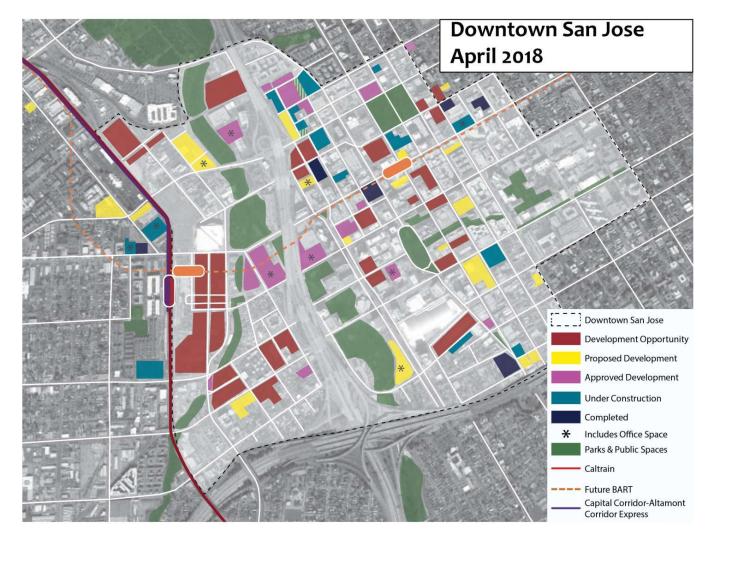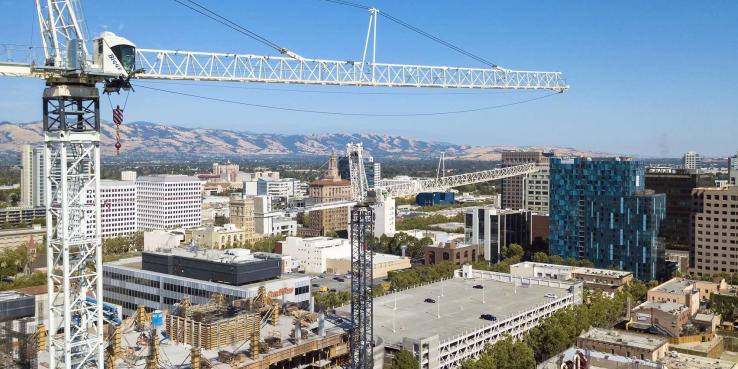In 2011, the City of San Jose adopted Envision 2040, an ambitious general plan to guide its transformation to a more urban place, increasing density and creating urban villages — vibrant mixed-use communities throughout the city. This plan included goals of bringing more than 10,000 new homes and nearly 50,000 jobs to downtown San Jose.
Each spring, SPUR reports on the progress San Jose is making toward realizing these goals. In 2017, we reported on several mixed signals related to downtown development. One year later, we are seeing a few new trends, as well as major decisions on the horizon. Storm clouds are also evident in the form of rising construction and land costs, which will likely impact the feasibility of new development in the coming year.
Trend 1. Breaking Ground
The pace of proposals, approvals and groundbreakings accelerated from spring 2017 to spring 2018. As of April 1, the housing development pipeline has grown by nearly 45 percent over the previous year, from 7,262 to 10,495 units proposed, approved or under construction — an amount that, once completed, would fulfill downtown’s general plan goals to the year 2040.
In last year’s update we noted that while many buildings had been approved, few had broken ground. Since then, no fewer than 8 projects began construction. The more than 3,300 new homes now under construction in the greater downtown will add thousands of new residents and energy to downtown San Jose, although not in the next year.
Though many have broken ground, no major projects have been completed since the Pierce Apartments on South First began leasing in February 2017. This reflects the two-year plus minimum timeline of high rises; nearly all buildings under construction will not begin leasing until at least 2019.
This rush of new construction beginning over the past year may be in response to the extension, until July 2018, of a 50 percent reduction in construction taxes and parkland fees for downtown high rises. It’s uncertain whether the current boom will last beyond the summer, when fees double, but even with the fee reduction, these new housing developments will pour more than $30 million into San Jose’s park fund.

Trend 2. Expanding Uses and Blurring Boundaries
In the past year, development in San Jose broadened, both geographically and in the diversity of uses. While nearly all projects completed between 2014 and 2017 were residential, a wide array of hotel, office and multiuse projects have been proposed and approved in the past year. For example, the pipeline of office developments has nearly doubled in the past year, with 4.35 million square feet of offices either approved or proposed, potentially adding more than 24,000 jobs to San Jose’s transit-connected core. Offices currently under construction include small spaces in mixed-use developments such as Modera at the Alameda (4,600 square feet). Hotel proposals have picked up as well, with over 1,000 rooms in the pipeline.
New proposals in the past year show that what were once considered the edges of downtown are expanding to the south, east and west.
As many as 1,200 new homes could be built in the South First Area (SoFA) arts district, including a proposal for the city’s tallest structure. Storefront venues, restaurants and breweries are keeping pace with the residential growth in SoFA, including the additions of Forager and Uproar Brewing Company. Hotel proposals are sprouting up as far south as Second and Reed streets, and as far northwest as Coleman Avenue.
On the east side of the downtown core, San Jose State University continues to expand its facilities and residential villages. Campus Village 2 added 850 beds in 2016, and another 1,500 are currently being designed as part of Campus Village 3, scheduled for completion in 2021. The Spartan Recreation and Aquatic Center is under construction and will house new tennis, softball and golf complexes.
Along West Julian, a million-square-foot office park has been proposed, as well as several more mixed-use projects. Further to the west, there are big plans beyond Highway 87 in the Diridon Station Area due to the largest real estate story of the past year: Google’s intent to build an urban campus surrounding Diridon Station. Google’s arrival at Diridon will entail a major shift in the center of economic gravity downtown. As a result, developers of office as well as residential properties are looking more favorably at the warehouses and parking lots west of Highway 87. Three large office complexes are in the works in the area west of the highway, with only one, the San Jose Water Company project, affiliated with Google. Indeed, the remaining large sites for development opportunity are all in the west, and many have been purchased by Google’s development partner, Trammell Crow. Since January 2017, Trammell Crow has spent more than $128 million to acquire 11.5 acres of land for Google’s new campus surrounding Diridon and is in exclusive negotiation with the City of San Jose to acquire an additional 23 acres, giving ample space for Google’s planned 20,000 downtown employees.
Trend 3. Anchors Double Down
Between land acquisition, approvals and community engagement around design and construction, the transit-oriented Google village at Diridon will not open for several years. In the meantime, San Jose’s existing economic and cultural anchors are expanding. In January 2018, Adobe purchased a property across the street from its existing campus, potentially doubling the size of the firm’s downtown presence. The Tech Museum has plans to grow as well. An unprecedented office/residential/hotel/cultural project was approved in August 2017. As we reported in last year’s update, there has been significant reinvestment in the past two years in the historic core of downtown San Jose, including both leases and redevelopments. The progress continues at the central intersection of First and Santa Clara streets, with three out of four corners on the way to major renovation. The new owners of the landmark Bank of Italy building have just acquired the neighboring Fountain Alley parking lot, potentially allowing for a building expansion alongside the renovation of the historic structure.
What’s Next
As Google’s village plans progress and residential and office development takes place alongside the banks of the Guadalupe River, SPUR, the City of San Jose and other city stakeholders have begun a serious effort to re-envision the river and parkway. While the final result is unknown and will be developed through a major engagement and visioning process, the enhancement of downtown San Jose’s greatest natural asset into an urban icon, community gathering place and commute corridor is essential.
San Jose’s new connections to the wider transportation network of the Bay Area are also key to it becoming a world-class city. The announcement that BART and VTA have settled on a tunneling method means that the BART extension may begin its next steps toward reaching downtown San Jose and joining the expanding list of transportation options that will intersect at Diridon. In the coming year, the City of San Jose’s Station Area Advisory Group will continue to give community input on the design and uses of the land around Diridon, San Jose’s central station.
Major issues of affordability and homelessness also persist, as well as concerns about the future feasibility of development in downtown and in the nearby urban villages of Central San Jose. The city faces a number of major decisions, all happening simultaneously. The challenge and opportunity will be to integrate each piece together and weave a cohesive downtown vision for a global city.
